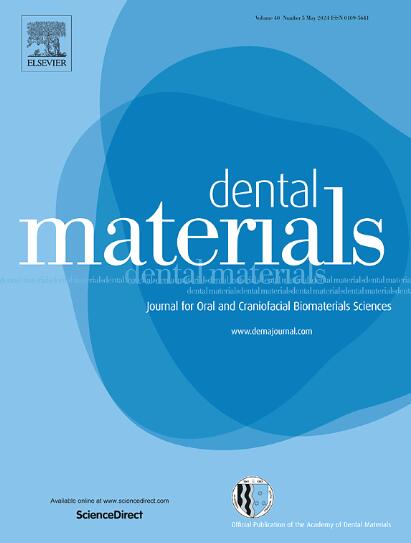Mapping water and monomer gradients in the adhesive/dentin interface with confocal micro-Raman imaging
IF 4.6
1区 医学
Q1 DENTISTRY, ORAL SURGERY & MEDICINE
引用次数: 0
Abstract
Objectives
Water in the adhesive/dentin (a/d) interface plays a crucial role in the quality of the hybrid layer (HL). This study aims to directly measure depth profiles of water content and adhesive monomers within the HL and explore the relationship between adhesive hydrophilicity and water content under wet bonding conditions using two model adhesives.
Methods
The occlusal one-third of the crown was removed from six unerupted human third molars. The exposed dentin surfaces were etched with 35 % phosphoric acid for 15 s, followed by the application of model adhesives with varying BisGMA/HEMA ratios (40/60 and 70/30) using the wet bonding technique. After light curing and 24 h of storage in water, the specimens were examined using a confocal Raman microscope under a 100x objective. Raman spectral imaging or mapping was performed at 1-micron intervals across the a/d interface in the Z direction. Reference spectra were obtained from model compounds, including type I collagen, BisGMA, HEMA, water, and the model adhesives, to generate calibration curves. These curves were then used to calculate the weight percentages of the components within the HL, which were subjected to statistical analysis (α = 0.05).
Results
Raman imaging shows that the HL is not a uniform structure, exhibiting gradients in both adhesive penetration and dentin demineralization. However, water content consistently remains higher in the HL compared to both the adhesive and underlying dentin. The water content in the HL formed by the model adhesives varies between approximately 9 % and 24 %, depending on location. This water content is strongly influenced by the hydrophobicity of the adhesives, with greater water accumulation at the bottom of the HL when a more hydrophobic adhesive (BisGMA/HEMA = 70/30) is used.
Significance
For the first time, the distribution of water, collagen, and adhesive within the HL has been quantified using confocal Raman microscopy combined with z-mapping. This technique allows for direct, nondestructive detection of the HL’s interfacial structure and composition.
用共聚焦微拉曼成像绘制粘合剂/牙本质界面中的水和单体梯度。
目的:黏合剂/牙本质(a/d)界面的水分对杂化层(HL)的质量起着至关重要的作用。本研究旨在直接测量HL内含水量和胶粘剂单体的深度分布,并利用两种模型胶粘剂探索湿键合条件下胶粘剂亲水性与含水量之间的关系。方法:对6颗未出牙的人第三磨牙进行三分之一牙冠的拔除。暴露的牙本质表面用35% %磷酸蚀刻15 s,然后使用湿粘合技术使用不同BisGMA/HEMA比率(40/60和70/30)的模型粘合剂。光固化后,在水中保存24 h,在100倍物镜下使用共聚焦拉曼显微镜检查标本。拉曼光谱成像或绘图在Z方向上沿a/d界面以1微米间隔进行。从模型化合物(包括I型胶原、BisGMA、HEMA、水和模型粘合剂)中获得参考光谱,生成校准曲线。然后用这些曲线计算HL内各组分的权重百分比,并进行统计分析(α = 0.05)。结果:拉曼成像显示HL结构不均匀,粘接剂渗透和牙本质脱矿均呈梯度。然而,与粘接剂和底层牙本质相比,HL中的水分含量始终较高。模型胶粘剂形成的HL中的含水量在大约9 %和24 %之间变化,取决于位置。该含水量受胶粘剂疏水性的强烈影响,当使用疏水性更强的胶粘剂(BisGMA/HEMA = 70/30)时,HL底部的水积聚更大。意义:利用共聚焦拉曼显微镜结合z-mapping技术,首次定量分析了HL内水分、胶原蛋白和黏合剂的分布。该技术可以直接、无损地检测HL的界面结构和组成。
本文章由计算机程序翻译,如有差异,请以英文原文为准。
求助全文
约1分钟内获得全文
求助全文
来源期刊

Dental Materials
工程技术-材料科学:生物材料
CiteScore
9.80
自引率
10.00%
发文量
290
审稿时长
67 days
期刊介绍:
Dental Materials publishes original research, review articles, and short communications.
Academy of Dental Materials members click here to register for free access to Dental Materials online.
The principal aim of Dental Materials is to promote rapid communication of scientific information between academia, industry, and the dental practitioner. Original Manuscripts on clinical and laboratory research of basic and applied character which focus on the properties or performance of dental materials or the reaction of host tissues to materials are given priority publication. Other acceptable topics include application technology in clinical dentistry and dental laboratory technology.
Comprehensive reviews and editorial commentaries on pertinent subjects will be considered.
 求助内容:
求助内容: 应助结果提醒方式:
应助结果提醒方式:


